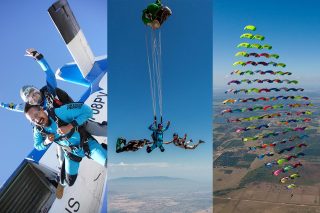How Does a Parachute Work?
Skydiving
Posted by: Skydive Perris
2 years ago
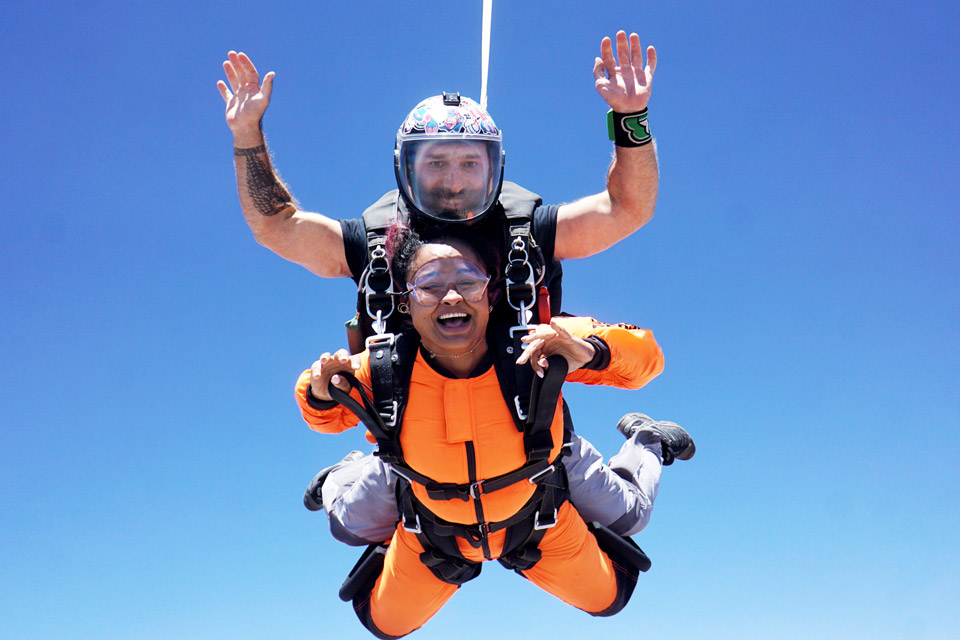
We all know how important it is for a parachute to open, but the big question is: HOW does a parachute work? There’s a lot of technology packed into that little backpack skydivers wear when they jump out of an airplane.
A good opening looks and feels smooth and effortless, and the logic behind how a parachute slows you down seems like a no-brainer, but the truth is there’s decades of work behind the process. The research involved to develop the countless technological advancements that go into making a parachute open and fly properly is straight-up awe-inspiring.
So how does a parachute work? Physics! And everyone knows how simple physics is (yeah, right!). We’ll try to break down the different aspects of canopy flight into bite sized pieces so it’s easier to understand exactly how a bunch of nylon and string gets jumpers to the ground safely.
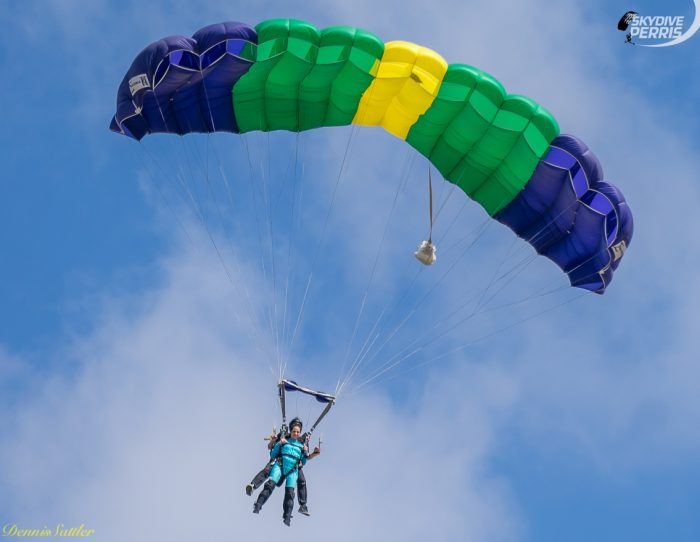
How Does a Parachute Open?
That sweet moment of life-saving bliss known as parachute deployment actually happens in three different phases. And believe it or not, only one of those phases is called deployment! Each phase leads to the next in a sort of chain reaction that starts as a fully packed parachute and ends with an open wing.
1. Activation
A hacky is attached to a small round parachute, called the pilot chute, that catches the wind and proceeds to extract the rest of the main parachute out of the container.
Once activation is complete, the rest of the opening is up to the technology built into the equipment.
2. Deployment
Here’s where the magic really starts to happen. The pilot chute pulls the main parachute and its lines out and away from the container until the lines become taut. At that point, the drag from the opening equipment begins to slow the jumper down.
The parachute lines are attached at the skydiver’s shoulders, and the resistance from the opening parachute begins to pull the skydiver into a vertical orientation.
Balance is key at this step. There’s only so much time for the parachute to deploy, but it’s also important that it doesn’t come out too quickly. Slowing down from 120 mph to 20 mph too fast would feel like a car accident! So parachutes have a few built-in features that result in organized, measured openings. Parachute deployment is all about timing!
3. Inflation
Ahh, like butter. The last step of parachute opening is the inflation. After everything is out of the container, the parachute begins to fill with air. A main parachute is made out of seven or nine cells (depending on the model) of zero-porosity nylon. The back of each cell is sewn shut, but the front is wide open. Imagine nine cones laid out side to side and stuck together. These cells fill with air and become rigid.
An inflated parachute looks just like the wing on an airplane, and flies like one, too! Now the skydiver can relax, hang out (literally), and steer the parachute wherever their heart desires.
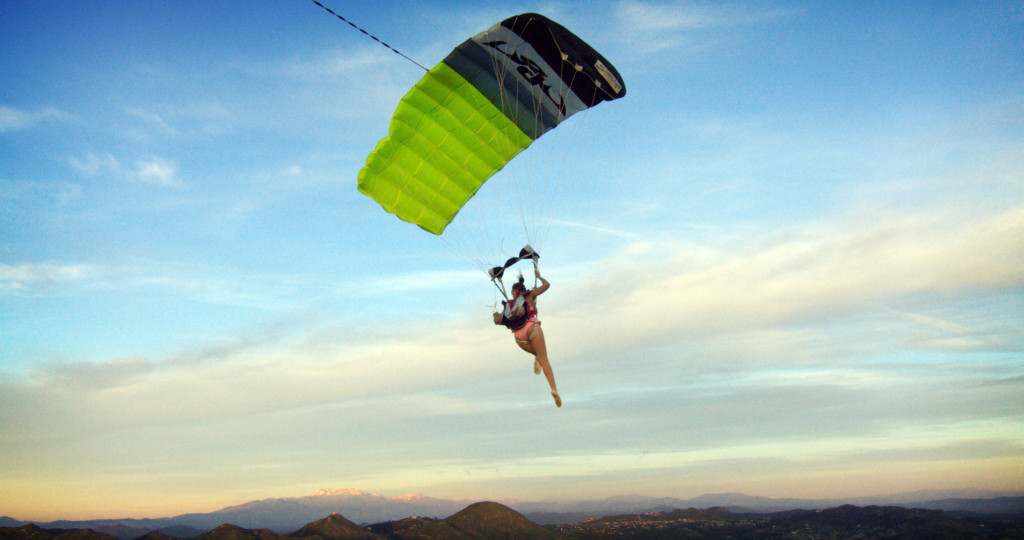
Main vs Reserve Parachutes
The main parachute is the workhorse of skydiving. Jump after jump, landing after landing, the main parachute opens and flies time and time again like ol’ reliable. Main parachutes are designed with safety in mind, but also performance. There are various disciplines experienced skydivers participate in, and the diversity of main parachute design reflects those choices.
Sometimes main parachutes fail. In fact, about one out of every 1,000 openings results in a malfunction requiring a cutaway. Sound like a lot? In reality, that many jumps could take an individual skydiver several years to accomplish. Plus, knowing the statistics empowers jumpers to prepare and train for a situation and be better equipped to deal with it.
It’s for this reason that the reserve parachute is designed with only safety in mind. Reserve parachutes are made to open consistently and to fly in a docile manner. Everything about the reserve is about emergency response. Fast openings for lower deployment, clean inflation to avoid a second malfunction, and slow, flat flight for a calm ride to the ground.
Reserve parachutes even have different regulations than main parachutes have. A reserve parachute has to be inspected and repacked every 180 days by an FAA certified rigger, regardless of whether it has been used. Skydivers don’t mess around when it comes to safety!
The Science Behind a Parachute
Now that it’s open, how does a parachute slow you down? A lot of people think of the old, round-style parachutes when they picture skydiving. Those parachutes worked in a pretty straightforward (roundforward? hehe) manner. They slowed jumpers down the same way a kid thinks jumping off a roof with a bed sheet would. They captured air and created drag as the jumper fell straight down below, or wherever the winds would push them (and it wasn’t always pleasant).
Parachutes nowadays are a lot more like a glider or wing. Once the parachute is rigid, the wing-like shape actually creates forward movement and lift. The top of the parachute has a bit of a hump shape to it, and that hump causes the air to travel farther over the top than it does under the flat bottom. This makes the air travel faster over the top, creating lower pressure than the air underneath.
Just like an airplane, this creates lift and allows the canopy to fly forward and down at a slower rate than simply falling. The lack of an engine means that skydivers can’t use the parachute to go up, but there is plenty to do with a wing capable of extended downward glide! Want to know more about how wings work? Read this article about the Bernoulli principle.
Using the parachute as a glider allows jumpers to steer the parachute wherever they want. This opens up the possibility for creative flight, swooping, and extremely accurate landings.
Flying a parachute is so much more than just a means to get from the sky to the ground! Want to experience how a parachute works in real time? Book here to take a ride with us!
Related Article: How Indoor Skydiving Works
Categories:
You May Be Interested In:

Unique California Experience Gifts for the Holidays
1 month ago by Skydive Perris

Skydiving Patches You Can Collect at Skydive Perris
3 months ago by Skydive Perris

Famous People Who’ve Jumped at Skydive Perris
3 months ago by Skydive Perris
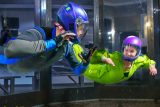
The Ultimate Family Hidden Gem in SoCal
6 months ago by Skydive Perris
